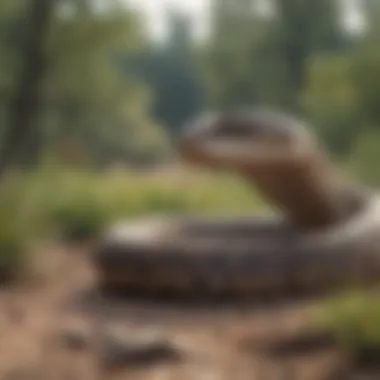Effective Strategies for Rattlesnake Management on Your Property


Intro
Rattlesnakes are a common concern for many homeowners, especially in areas close to their natural habitats. Recognizing the importance of addressing rattlesnake encounters entails understanding the species, their behaviors, and effective ways to manage their presence on your property. This guide will provide practical solutions and insights into peaceful coexistence or proper removal, ensuring safety for both humans and wildlife.
Animal Species Profile
Preamble to the Animal Species
Rattlesnakes belong to the family Viperidae, characterized by their distinctive rattles, which serve as a warning. There are several species that fall within this group, with the Western Diamondback and Eastern Diamondback being two of the most well-known. This species plays an essential role in maintaining the ecosystem balance by regulating the populations of their prey, primarily rodents.
Physical Characteristics and Appearance
Rattlesnakes exhibit a range of patterns and coloration that aid in camouflage against their natural surroundings. They typically have a triangular-shaped head, long slender body, and of course, the iconic rattle at the tail. This rattle is made of keratin, a similar material to human nails, and creates a distinctive warning sound when vibrated. The size varies, but many species can reach lengths of 4 to 6 feet.
Natural Habitat and Distribution
These snakes thrive in diverse habitats, including deserts, grasslands, and rocky terrains. They are primarily found in North and South America, with the United States hosting a significant population. Warm, dry regions are common, although some species also adapted to forests and scrublands, seeking cover and hunting grounds.
Behavior and Social Interactions
Rattlesnakes are generally solitary creatures, except during the mating season. They exhibit unique territorial behavior and can often be seen basking in the sun during cooler months. Their communication involves a series of displays, including positioning themselves in a defensive posture and rattling, which tells potential threats to keep their distance. Understanding this behavior is key when addressing encounters on private properties.
Conservation & Wildlife Efforts
Overview of Conservation Status
The various species of rattlesnakes vary in conservation status, with some being classified as threatened or endangered. Habitat loss, climate change, and direct persecution have contributed to declines in populations across North America.
Threats to the Species
The primary threats to rattlesnake populations include habitat destruction due to urban development and agriculture. Additionally, persecution driven by fear and misunderstanding often leads to unnecessary killings. These practices jeopardize not only the rattlesnakes but the ecosystems they support.
Conservation Initiatives and Organizations
Efforts to conserve rattlesnake populations include education programs aimed at reducing fear among communities, alongside habitat restoration projects. Organizations like the U.S. Fish and Wildlife Service and various local wildlife conservation groups play essential roles in promoting awareness and protective measures.
Success Stories and Impact
Successful conservation initiatives, like those advocating for the preservation of critical habitats and focused education campaigns, have resulted in positive outcomes for certain rattlesnake species. Observation of healthier populations in designated protected areas indicates the effectiveness of these efforts.
Animal Behavior & Psychology
Understanding rattlesnake behavior adds another layer of consideration for safety and conservation.
Communication and Language Cues
Rattlesnakes communicate primarily through body language and sound. Rattling serves as a last resort—a warning rather than an aggressive act, aiming to deter predators or threats.
Reproductive Behavior and Parenting
During mating season, males engage in combat to vie for females, demonstrating physical strength and dominance. After mating, females give birth to live young, providing the necessary care to a small cohort of offspring.
Cognitive Abilities and Problem-Solving Skills
Research indicates that rattlesnakes possess basic problem-solving skills, using environmental cues to navigate and hunt effectively.
Emotional Intelligence and Social Dynamics
Although perceptions of rattlesnakes often lean towards fear-driven narratives, more nuanced studies reveal they may exhibit simple forms of social behaviors, indicating a level of emotional processing uncommon in reptiles.
Unique Facts & Trivia
Little-Known Facts About the Animal
Rattlesnakes can sense heat through specialized pits located on their faces, allowing them to detect warm-blooded animals from considerable distances.


Surprising Behaviors or Adaptations
Some species have incredible ability to survive without eating for extended periods, lasting several months or even longer.
Fun Trivia and Quirky Behaviors
Rattlesnakes may use their rattles to deter larger predators, and they often adopt markings mimicking surrounding rocks or branches, enhancing their ability to remain unseen.
Record-Breaking Feats or Abilities
One of the largest rattlesnakes on record measured about 8 feet long. This highlights the significant variations within the species.
Pet Care & Tips
Choosing the Right Pet for Your Lifestyle
For folks who choose snakes as pets, understanding rattlesnakes' requirements is crucial. They are not recommended for beginners, as their care involves specific habitat needs and handling concerns.
Basic Care Requirements and Habitat Setup
Proper habitat includes adequate space, hiding spots, and varied temperatures to maintain the snake's health and comfort.
Health and Wellness Tips for Pet Longevity
Regular vet check-ups and attention to dietary needs also significantly contribute to longevity.
Training Techniques and Behavioral Enrichment Ideas
While rattlesnakes do not typically require training like dogs, providing environmental enrichments, such as varied substrates or climbing decor, can promote mental health.
In managing rattlesnake encounters on your property, a foundational understanding of their biology and behavior, alongside strategic preventive measures, can yield more effective resolution and promote a respectful coexistence with wildlife.
Intro to Rattlesnakes
The presence of rattlesnakes on residential properties is a serious concern for many homeowners. Understanding their behavior and biology is crucial for safely managing encounters and minimizing risks. This article aims to provide a complete guide to effectively deal with rattlesnakes while ensuring the preservation of local wildlife.
Understanding Rattlesnake Behavior
Rattlesnakes are part of the pit viper family and exhibit specific behaviors that are essential for their survival. They are predominantly solitary creatures, preferring to remain hidden until necessary. This behavioral trait often leads them to occupy places like tall grass, underbrush, or rocky crevices. Knowing when rattlesnakes are most active can also greatly aid in avoidance. Generally, they tend to be nocturnal in cooler months but become diurnal during warmer seasons.
Their defensive mechanisms are critical to understand. When feeling threatened, a rattlesnake shakes its rattle to warn intruders. This behavior is often a signal that they prefer to avoid confrontation. It is essential to note that they will strike when directly threatened, so it is wise to respect their space and keep a safe distance if encountered.
Implementing practical strategies around your property can help to mitigate rattlesnake presence, making understanding their behavior even more imperative. Awareness of their patterns will allow homeowners to adjust their landscape accordingly and choose appropriate removal strategies.
Identifying Rattlesnakes
Correct identification of rattlesnakes versus non-venomous snakes is crucial. Rattlesnakes typically possess a distinct triangular-shaped head and a characteristic rattle at the end of their tail. Their skin can vary widely in color, which may help them blend into their environment—often shades of brown, gray, or even greenish tones. Here are some key identifiers:
- Tail: The presence of the rattle is a primary feature. This structure is made up of modified scales and is crucial for both communication and warning.
- Body Features: Rattlesnakes have a robust body, often displaying dark banding over lighter base colors.
- Eyes: They have elliptical pupils, contrasting with the round pupils found in non-venomous snakes.
If identification remains unclear, maintaining a safe distance while observing behaviors will assist state wildlife officials in providing guidance. In any case, whether a rattlesnake is present depends greatly on local environmental factors, which can change seasonally. Familiarity with these details will help foster a balanced coexistence with local fauna.
Assessing Your Property
Assessing your property is a crucial first step in managing rattlesnake encounters effectively. Understanding the layout, features, and ecological conditions of your property will help identify potential risks and inform preventative measures. A thorough assessment allows homeowners to recognize vulnerabilities that might attract rattlesnakes, guiding them toward suitable actions. Knowing the aspects of your property can ensure a proactive approach rather than a reactive one.
Common Habitat Preferences
Rattlesnakes are often found in specific habitats that meet their needs for shelter, temperature regulation, and hunting. They favor rocky areas, tall grass, and spots with ample cover. Some key features include:
- Rocks and debris: These provide hiding spots. Rattlesnakes seek out places to avoid predation and to rest during the day.
- Tall grass and dense brush: They use these areas for camouflage while waiting for prey such as rodents.
- Sunny spots: Rattlesnakes often find sunlit areas to bask and regulate their body temperature.
Landscaping materials like wood piles or landscape bricks can not only provide attractive features for homeowners but can also unwittingly become havens for snakes. Understanding these preferences is vital for adapting your environment accordingly, minimizing the snake population on or near your property.
Signs of Rattlesnake Presence
Detecting the signs of rattlesnakes is essential for assessing your property. Homeowners should be vigilant for the following indicators:


- Shed skins: Snakes regularly shed their skins and may leave these empty sheddings in the vicinity.
- Droppings: Rattlesnake droppings may consist of indigestible parts of their meals, such as bones or fur, appearing dark and cylindrical.
- Track patterns: Look for faint impressions in the soil, indicating snakes slithering in and out of specific areas.
- Density of rodent populations: Rattlesnakes often follow food sources, such as rodents, into populated spaces.
By being mindful of these signs, homeowners can gauge the level of rattlesnake activity on their property. Early detection enables individuals to manage their environment more effectively and implement necessary mitigation strategies.
Detecting the presence of rattlesnakes at an early stage reduces both risk and potential panic in emergency situations.
Preventative Measures
In managing rattlesnake presence on a property, preventative measures play a critical role. The importance cannot be understated. By adopting proactive strategies, homeowners can significantly reduce the likelihood of an encounter. Ensuring safety aids not just the residents and pets, but also the rattlesnakes themselves, fostering a respectful wildlifeociety with minimized risks.
Several specific elements encompass effective prevention tactics. Firstly, they cultivate changes in the habitat to discourage rattlesnakes from settling near residences. Secondly, preventative methods enhance the quality of life for both local wildlife and property owners. Prioritizing prevention thus intertwines with ecological respect.
Lastly, it prepares the ground for potential encounters by equipping property owners with the tools to manage wildlife responsibly. Overall, taking action before an incident occurs can save stress, injuries, and the need for removal.
Landscaping Tips to Deter Rattlesnakes
Landscaping plays a vital role in reducing the likelihood of rattlesnake presence. Creating an environment less inviting for them is crucial. Here are some effective tips:
- Maintain a clear yard: Cutting grass short and removing debris like wood piles or rocks can reduce potential hiding spots.
- Plant specific vegetation: Opt for non-native plants that do not attract rattlesnake prey, such as rodents. For instance, decorative cactus plants may serve as deterrents.
- Install barriers: Bordering gardens or flower beds with gravel or rocks can distract snakes with a surface they would rather avoid. Gravel radiates heat, making movement uncomfortable for them.
Furthermore, be cautious about composting or vegetable gardens. Any scattered food fragments may attract unwanted wildlife, which can in turn attract snakes looking for prey.
Fencing Solutions
Fencing presents another beneficial strategy in keeping rattlesnakes at bay. Effective fencing solutions must adhere to certain guidelines for maximum efficacy. Consider these:
- Height and installation angle: Fences should be at least four feet high. Installing it at a slight angle can make climbing tricky for snakes.
- Material selection: Use wire mesh fabric with holes no larger than six inches. Some commercially available options specifically cater to snake deterrence.
- Regular checks and maintenance: Inspect the fencing frequently to seal any gaps or damage that could let snakes go through.
Fences can serve not only as physical barriers but also a calculated deterrent, limiting snake access greatly. Thus, these preventative steps contribute toward creating a waveform for coexistence between residents and rattlesnakes sheltering nearby.
Effective preventative measures position property owners favorably. Not only helps safety, but such measures become integral parts of the community's ecological strategy.
Safe Removal Techniques
The concept of safe removal techniques is vital in addressing rattlesnake encounters on residential properties. Enforcing these techniques supports not only the safety of people and pets but also a greater emphasis on wildlife preservation. By adopting informed and practical methods for removal, homeowners can mitigate risks linked to aggressive snake behavior or potential bites, all while maintaining respect for these reptiles.
When to Call Professionals
Deciding when to involve professional vermin control services is key. Homeowners often face challenging situations, such as encountering a rattlesnake in an elevated space or near children. Taking noticeable caution in these scenarios is critical.
- Safety First: A professional knows how to securely handle snakes without additional danger. This is particularly important in complicated environments such as basements or sheds.
- Local Knowledge: Wildlife practitioners often have insights about common rattlesnake behaviors specific to local regions. This can be invaluable knowledge for placement of traps or identification of nesting sites.
- Avoiding Displacement: Trained individuals cleanly relocate snakes without inadvertently harming them, maintaining ecological standards. If in doubt about safety, consult a specialist.
Before decision-making:
- Consider the snake’s behavior.
- Assess immediate surroundings.
- Ensure attempts to remove the snake do not lead to escalating aggression.
DIY Removal Strategies
Selecting to remove rattlesnakes personally requires careful planning and awareness. DIY strategies may vary in effectiveness, depending on the experience and confidence of the person attempting removal.
- Appropriate Tools: Equip yourself with long grabbers and snake hooks. These tools facilitate a non-violent arrest without risking close encounters.
- Best Timing: It is advantageous to attempt removal during cooler temperatures when rattlesnakes are slower.
- Safety Precautions: Always wear thick gloves and protective eyewear, as rattlesnakes can bite when startled.
- Movement Control: Gently coax the snake into a sturdy container like a plastic or cardboard box. The motion should be slow to avoid irritating snakes further.
- Research and Awareness: Before attempting removal, one should educate themselves on specific species found locally. This can prevent unnecessary conflicts rooted in misunderstanding.
It’s crucial to stay aware of personal limits. Leaving removal to professionals when uncertainty arises protects both individuals and the local wildlife. Recognizing vital constraints in your capability is equally important as a dedicated intention of wildlife ya.
Remember, dedicated practice in safe removal not only aids community safety but is aligned with conservation efforts sustaining local ecology.
Handling Rattlesnake Encounters
Encounters with rattlesnakes can evoke fear and uncertainty. Understanding how to manage these situations effectively is essential for ensuring safety for both humans and wildlife. The right response can prevent dangerous encounters and preserve local ecosystems. Proper handling of rattlesnake encounters contributes to informed behavior and responsible action when met with these reptiles.
Emergency Response Steps
When confronting a rattlesnake, it is crucial to remain calm. Panic may lead to rash decisions that can worsen the situation. Here are steps to take immediately:
- Stay Still: Most rattlesnakes will not strike unless threatened. Remaining still can help the snake feel less inclined to defend itself.
- Identify Your Location: Be aware of your surroundings so you can describe the position of the snake if needed. Take note of landmarks to help convey your location to others.
- Create Distance: Slowly move away from the snake. Maintain a safe distance without making sudden movements which could provoke the animal.
- Alert Others: If others are nearby, make them aware of the snake's location and advise them to stay away.
- Call for Help: If the snake is situated in a public area or doesn't leave on its own, contact local wildlife authorities or animal control for assistance. They approach the situation with the required experience.


Staying calm and respecting the wildlife in your area promotes safer encounters and emphasizes the importance of effective communication in emergencies.
First Aid for Rattlesnake Bites
In case of a rattlesnake bite, immediate medical attention is essential. Understanding the proper first aid measures can save lives. Here’s what to do:
- Seek Medical Assistance: Call emergency services as soon as possible. Transport the victim to the nearest hospital equipped to treat snake bites.
- Decrease Movement: Keep the affected area immobilized below heart level. Movement can increase blood flow and spread venom.
- Remove Tight Items: Take off any jewelry or tight clothing near the bite site. This can relieve pressure caused by swelling.
- Keep the Patient Calm: Anxiety can elevate heart rates, increasing the dispersion of venom, so reassure the victim and help keep them calm.
- Do Not apply ice, attempt to suck out the venom, or use a tourniquet as these methods can worsen the damage.
Proper education on handling rattlesnake encounters fosters respect for these animals while prioritizing public safety. Knowing how to respond mitigates risks and promotes coexistence, acknowledging rattlesnakes have their place within nature. Homeowners, educators, and wildlife enthusiasts should actively engage in learning these practices for the benefit of communities and wildlife alike.
Legal Considerations
Understanding the legal framework surrounding rattlesnake interactions is crucial for homeowners. Laws regarding wildlife vary significantly by location. Complying with these regulations can help prevent unwanted encounters and potential conflicts between humans and wildlife. Failure to follow local ordinances could result in fines or legal action.
Local Wildlife Regulations
Each state has distinctive laws that govern the treatment and interaction with rattlesnakes. For instance, some areas protect rattlesnake populations, making it illegal to harm or kill them without special permits. It is essential to research and understand local wildlife regulations.
Likely regulations to consider include:
- Endangered Species Protection: If rattlesnakes are categorized as endangered in your region, legal implications arise.
- Permit Requirements: Some jurisdictions necessitate permits for removal or relocation of rattlesnakes.
- Tolerance Policies: Certain communities may encourage tolerance for harmless snakes, promoting coexistence.
Keep records of your communications with local wildlife authorities if needing clarification about these laws;
Conservation Efforts and Best Practices
Engagement in conservation efforts plays an important role in wildlife management. By understanding rattlesnake behavior and their ecological significance, homeowners can contribute positively to local ecosystems. Specifically, this involves:
- Habitat Enhancement: Maintain natural habitats that support a balance between rattlesnakes and humans. This might involve minimizing methambling actions that derail progress
- Community Programs: Participating in local workshops provides expanded knowledge about rattle snakes, making communities more informed.
Work collaboratively with wildlife centers and community boards to ensure snake populations remain healthy. Conservation practices often lead to healthier ecosystems that benefit both residents and species alike.
Legal guidelines are not merely restrictions; they can help safeguard biodiversity and encourage safe human-wildlife interactions.
By applying these insights, homeowners lay the groundwork for a responsible attitude towards rattlesnakes, while ensuring safety on their properties and their local areas.
Coexisting with Rattlesnakes
The presence of rattlesnakes can create distress for property owners. However, embracing the possibility of coexisting with these creatures may have notable benefits. Understanding rattlesnake behavior will help reduce fear and uncertainty. By taking well-informed measures, homeowners can support a balanced ecosystem while minimizing risks that come with snake interactions.
Collaborating with local wildlife experts can lead to significant understanding of rattlesnakes. Learning about their habits improves safety while also aiding in their conservation. Various educational strategies can ensure the community feels equipped to deal with encounters in responsible ways.
Educational Outreach
Implementing effective educational outreach programs is central in promoting awareness about rattlesnake behavior and habitat. Schools, community organizations, and wildlife agencies can participate in providing resources about how to live alongside snakes.
Here are some key aspects of educational outreach:
- Workshops and Seminars: Informative sessions where experts explain rattlesnake characteristics, their ecological role, and proper safety techniques.
- Printed Materials: Brochures or flyers can function as easy-reference tools. They should highlight first aid measures, signs of snake activity, and ways to adjust behaviors to avoid encounters.
- School Programs: Getting students to learn about rattlesnakes creates engagement from a young age. Incorporating discussions, visual aids, or even field trips enhances understanding
Ensuring accurate information is disseminated through credible sources can contribute towards reducing fear and anxiety. Fact-based messages can encourage respect for rattlesnakes while providing safety strategies.
Community Involvement
Community involvement plays a vital role in managing and supporting rattlesnake populations while maintaining public safety. Residents who work together can create environments responsive to both human and wildlife needs.
Several initiatives can encourage a proactive community approach:
- Organized Clean-Up Days: These activities can remove potential snake habitats within yards and properties, minimizing the chance of making rattlesnakeπ homes near human activity.
- Community Meetings: Gathering people can facilitate open dialogue. Discussing local experiences and exchanging ideas encourages best-safety practices.
- Volunteer Programs: Setting up local volunteer groups dedicated to monitoring rattlesnake populations aids in understanding their movement. This data helps identify troublesome regions.
Establishing a connection with wildlife experts fosters shared responsibility. When understanding between humans and rattlesnakes prevails, everyone's interest is maximized. The end result can bring about a culture of coexistence rather than conflict with nature.
Finale
Understanding rattlesnakes and how to manage their presence on your property is a significant aspect for many homeowners. This article outlines practical steps and considerations, focusing on reducing encounters and enhancing safety for both humans and wildlife.
Summary of Key Points
- Rattlesnake Behavior: Recognizing the behavior of rattlesnakes helps in predicting encounters and minimizing risk. Awareness of when snakes are most active can inform property management.
- Habitat and Habitat Preferences: Learning about the kinds of environments preferred by rattlesnakes is essential for effective prevention. This knowledge allows homeowners to make lifestyle changes that reduce attractive conditions.
- Preventative Measures: Various techniques, such as modifications to landscaping and installation of fences, can act as effective deterrents against snakes.
- Safe Removal: Understanding when to call professionals ensures safe and humane removal. Furthermore, having DIY techniques in mind empowers individuals to respond correctly in suitable situations.
- Legal Framework: Awareness of local wildlife regulations is essential to ensure responsible and lawful management of rattlesnakes.
- Coexistence Practices: Engaging in educational outreach and community efforts promotes a better understanding and fosters harmony between people and local wildlife.
In summary, the completion of this article provides a fuller picture of how to tackle rattlesnake encounters responsibly. The insights covered reinforce the idea that respecting wildlife, while ensuring human safety, should be the cornerstone of any wildlife management strategy.
Proper measures alongside public education are crucial for effective wildlife cohabitation.







